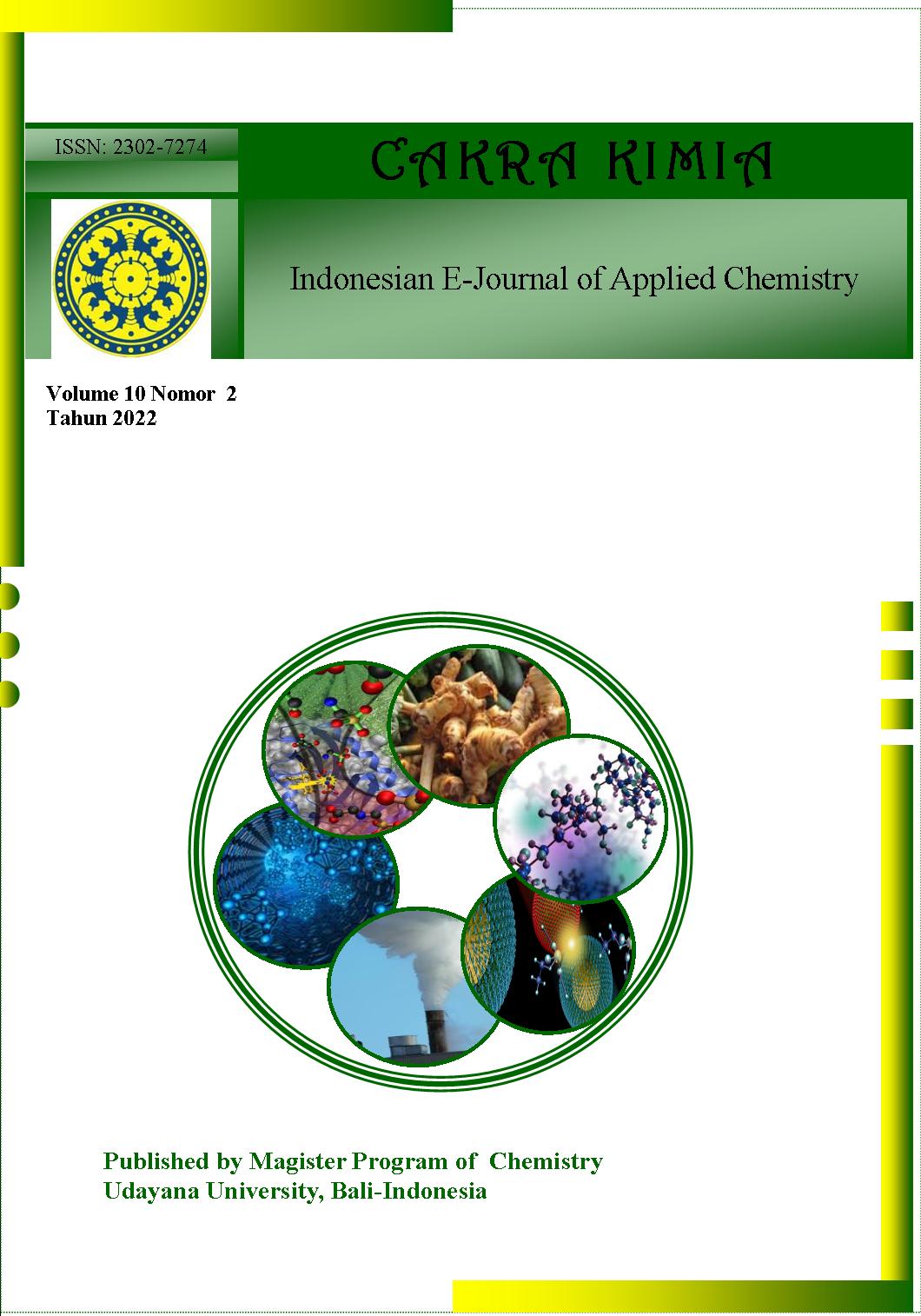POTENSI EKSTRAK ETANOL DAUN PUTRI MALU (Mimosa pudica L.) SEBAGAI OBAT ALTERNATIF ANTIHIPERGLIKEMIA
Abstract
ABSTRAK: Penelitian ini bertujuan untuk mengetahui potensi ekstrak etanol daun putri malu (Mimosa pudica L) sebagai antihiperglikemia melalui penurunan kadar glukosa darah dan malondialdehide (MDA) tikus putih galur Wistar yang diinduksi streptozotocin. Uji penurunan glukosa darah dan malondialdehide menggunakan 24 ekor tikus Wistar yang dibagi menjadi 6 kelompok yaitu tiga kelompok kontrol dan tiga kelompok perlakuan dengan beragam dosis ekstrak daun putri malu. Dosis yang digunakan pada masing-masing kelompok perlakuan adalah 50, 100, dan 150 mg/kg BB. Kondisi hiperglikemia pada hewan uji dibuat dengan induksi streptozotocin dosis 40 mg/kg BB. Hasil penelitian menunjukkan bahwa ekstrak etanol daun putri malu dapat menurunkan kadar glukosa darah tikus Wistar hiperglikemik dengan dosis 50, 100, 150 mg/kgBB sebesar 45.97, 62.07, 75.27 mg/dL dan penurunan kadar malondialdehide sebesar 2.59, 5.01, 6.01 ?M terhadap kontrol negatif. Perbedaan penurunan rerata kadar glukosa darah dan MDA ini dianalisis dengan metode One Way ANOVA dan didapatkan hasil bahwa semua data dari setiap kelompok memiliki perbedaan yang signifikan. Hasil Analisis LC-MS/MS ekstrak etanol daun putri malu teridentifikasi 8 senyawa. Dari 8 senyawa yang teridentifikasi, luteolin dan apigenin merupakan senyawa yang diketahui berperan sebagai antihiperglikemia.
ABSTRACT: The purposes of this research are to determine the potential of Mimosa leaves (Mimosa pudica L) ethanol extract as the antihyperglycemic agent by reducing blood glucose and malondialdehyde (MDA) levels of streptozotocin-induced white rats of Wistar strain. Tests for reducing blood glucose and malondialdehyde used 24 Wistar rats which were divided into 6 groups, namely three control groups and three treatment groups with various doses of mimosa leaf extract. The doses used in each treatment group were 50, 100, and 150 mg/kg BW. Hyperglycemic conditions in test animals were made by induction of streptozotocin at a dose of 40 mg/kg BW. The results showed that the ethanol extract of mimosa leaves could reduce blood glucose levels of hyperglycemic Wistar rats with doses of 50, 100, 150 mg/kg BW by 45.97, 62.07, 75.27 mg/dL and a decrease in malondialdehyde levels by 2.59, 5.01, 6.01 µM against negative controls. The difference in the average decrease in blood glucose and MDA levels was analyzed by the One Way ANOVA method and the results showed that all data from each group had significant differences. The results of the LC-MS/MS analysis of the ethanol extract of the mimosa leaves identified 8 compounds. Of the 8 compounds identified, luteolin and apigenin are compounds known to act as antihyperglycemic agents.
Downloads
References
[2] PERKENI, Konsensus Pengolahan Dislipidemia di Indonesia, Jakarta: Pusat Penerbitan Ilmu Penyakit Dalam Fakultas Kedokteran UI, 2012.
[3] I. N. Suarsana, I. H. Utama, I. G. Agung and A. Suartini, "Pengaruh Hiperglikemia dan Vitamin E pada Kadar Malonaldehida dan Enzim Antioksidan Intrasel Jaringan Pankreas Tikus," Majalah Kedokteran Bandung, vol. 43, no. 2, 2011.
[4] F. W. F. Wong, M. E. Khayat, Z. M. Sobri and A. B. Ariff, "The Potencial of Mimosa pudica as Biopreservative forFood Products : A Bio Processing Perspective," Nutrion & Food Science International Journal, vol. 5, no. 3, 2018.
[5] S. T. Tusnava, U. A. Qamar, K. Ghafoor, F. Sahena, M. H. A. Jahurul, A. H. Rukshana, M. J. Juliana, F. Y. Al-Juhaimi, L. J. K. C. A. Jalal, M. E. Ali and I. S. M. Zaidul, "α-glucidase Inhibitor Isolated from Mimosa pudica L.," Natural Product Research, vol. 30, no. 10, 2017.
[6] K. Mustapa, A. Rizky and M. R. Jura, "Pengaruh Ekstrak Tanaman Putri Malu (Mimosa pudica Linn) Terhadap Penurunan Kadar Glukosa Darah Pada Mencit (Mus Musculus)," Jurnal Akademika Kimia, vol. 6, no. 1, pp. 7-14, 2017.
[7] E. A. Harijanto and A. M. Dewajanti, "Optimasilisasi Pemberian Streptozotocin Beberapa Dosis Terhadap Peningkatan Kadar Glukosa Darah Tikus Sprague dawley," Jurnal Kedokteran Mediatek, vol. 23, no. 63, 2017.
[8] W. Tresnawati and F. A. Saputri, "Review: Analisis Penentuan Glibenklamid Dalam," Farmaka Suplemen, vol. 4, no. 2, 2016.
[9] N. S. Hardiany, Sucitra and R. Paramita, "Profile of Malondialdehyde (MDA) and Catalase Spesific Activity in Plasma of Elderly Woman," Healt Science Journal of Indonesia, vol. 10, no. 2, 2019.
[10] U. K. Mondol and W. Islam, "Evaluation of Antioxidant Activity of Mimosa pudica L. Extracts," International Journal of Biological and Pharmaceutical Sciences Archive, vol. 03, no. 01, pp. 015-020, 2022.
[11] S. Parasuraman, T. H. Ching, C. H. Leong and U. Banik, "Antidiabetic and Athihyperlipidemic Effects of a Methabolic Extract of Mimosa pudica (Fabaceae) in Diabetic Rats," Egyptian Journal Of Basic And Applied Sciences, vol. 6, no. 1, pp. 137-148, 2019.
[12] G. Patro, S. K. Bhattamisra, B. K. Mohanty and H. B. Sahoo, "In Vitro and in Vivo Antioxidant Evaluation and Estimation of Total Phenolic, Flavonoid Content of Mimosa pudica L," Pharmacognosy Research, vol. 8, no. 1, 2016.



 Petunjuk Penulisan
Petunjuk Penulisan
